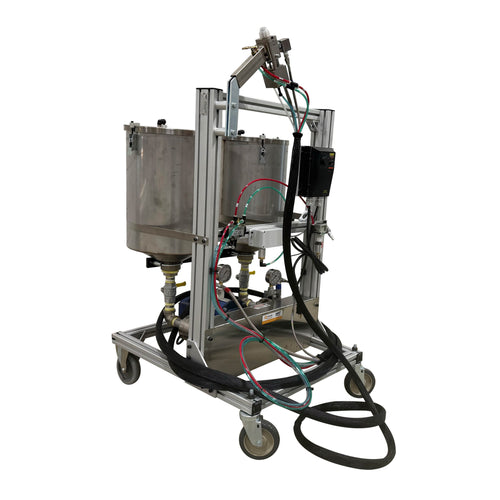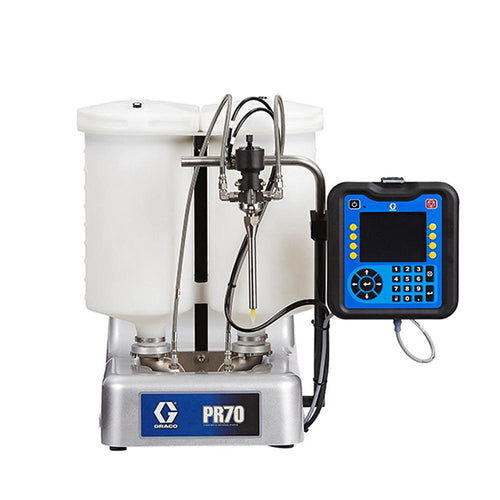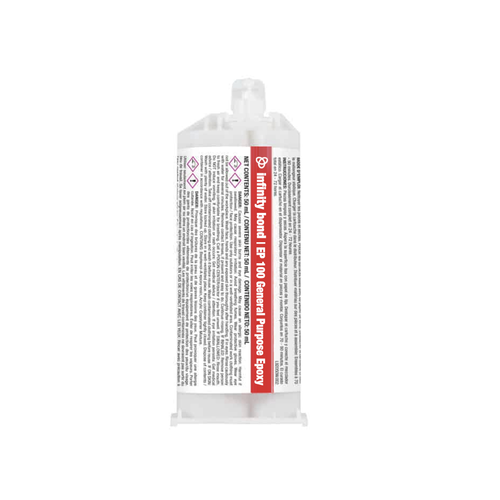April 18, 2025
Jump to:
- What Is a Bridge Deck Overlay
- Different Types of Overlay Materials
- Choosing the Right Overlay
- Applying an Epoxy Overlay
- Recommended Dispensing Equipment
There are over 617,000 bridges in the United States.1 These bridges are critical infrastructure that facilitate the efficient movement of people and goods across the country. Unfortunately, a significant number of these bridges are in less than optimal condition.
According to one study from 2021, 42% of bridges are over 50 years old, and more concerningly, 7.5% of bridges in the United States are classified as structurally deficient. In particular, 5.5% of bridge deck areas met this structurally deficient mark in 2019.1
This deterioration comes largely from the prolonged effects of deicing salt, but several other environmental conditions can contribute, including exposure to UV light, wear and tear from vehicles, freeze-thaw cycles, water infiltration, and more. Combined, these factors can lead to cracking, spalling, delamination, and corrosion of the reinforcing steel. This widespread damage poses significant safety risks as time passes without substantial repairs or steps for rehabilitation.
Local, state, and national governments strive to reduce the amount of structurally deficient bridges in the nation, but full replacement is a substantial monetary drain and time commitment. Rehabilitation and repairs can be a time- and cost-savings solution that can still improve safety standards and the overall condition of the bridge. This is where bridge deck overlays can come in.
What Is a Bridge Deck Overlay?
A bridge deck overlay is a layer or topcoat applied to the surface of a bridge deck to repair, safeguard, or extend the service life of a bridge. They can be made out of epoxy, asphalt, polyester, silica, and other materials. Bridge deck overlays can be a cost-effective solution to restore the integrity of existing bridges and improve their safety when the underlying structure is still intact. These bridges may have an exposed structure or a deteriorated deck from corrosion, delamination, and cracking.
Bridge deck overlays can also be applied to newly constructed bridges to enhance their durability, prevent future damage, and ultimately, prolong their operational lifespan.
Different Types of Overlay Materials
The development of bridge deck overlays was driven by the increasing demand for more durable bridges as automobile traffic and load capacities grew. Over the years, different types of bridge deck overlay materials were used as technology advanced and the needs of infrastructure evolved.
Some types of bridge deck overlays include:
-
Asphalt
-
Latex modified concrete (LMC)
-
Epoxy polymer concrete
-
Portland cement concrete
-
Polyester polymer concrete
-
Silica fume (microsilica) concrete
-
Silane sealers
Asphalt Overlays: Asphalt bridge deck overlays were one of the first types of overlays and can be applied with or without a membrane. They were valued for their ease of application and relatively low cost. On the downside, they tend to have a short service life, especially on high-trafficked bridges. By some estimates, asphalt bridge deck overlays may only last 15 years before more restoration is needed.2 Another big downfall of asphalt overlays is their weight. As a result, most people have moved away from them.
Latex Modified Concrete (LMC): Latex modified concrete overlays are another type of bridge deck overlay that combines hydraulic cement and aggregates with organic polymers that are dispersed or redispersed in water. LMC overlays have lower chloride permeability than traditional concrete and are more durable. They have a longer service life than asphalt overlays of 18 or more years.2
Polyester Polymer Concrete: A polyester-based overlay has a polyester binder. These bridge overlays have a short working life and cure time, so traffic can resume quickly after placement. Polyester-based overlays have good resistance to chemicals that can increase the bridge's service life. The installation of a polyester polymer concrete overlay can be more challenging. They should not be applied at temperatures below 50 degrees Fahrenheit and a primer is necessary.
Epoxy Polymer Concrete: Epoxy-based bridge deck overlays are a type of polymer concrete overlay with an epoxy binder. Other binders for polymer concrete overlays can include polyurethanes, methacrylates, and polyesters. Epoxy overlays have a high compressive strength and bond strength. They also have a high resistance to water, deicing salts, and other chemicals that often lead to bridge degradation. Because of their short work life and curing time, epoxy-based overlays are easy to install and have a fast turnaround time to resume bridge service. With all these benefits, covering bridge decks with epoxy overlay is growing in popularity and has become a top choice for many in the industry.
Choosing the Right Overlay
Each type of overlay material has advantages and limitations. Consequently, some overlays have greater durability and will last longer in specific environments than others. When determining what type of bridge deck overlay to choose, it is important to take the following into consideration:
-
Bridge size
-
Bridge condition
-
Environment
-
Traffic volume
-
Labor costs
-
Equipment costs
-
Traffic control requirements
-
Timeline
Selecting the appropriate overlay material and ensuring its proper application can significantly extend the service life of bridges.
Applying an Epoxy Overlay for Bridge Decks

Because epoxy is such a popular material for this application, we are going to focus on how to apply an epoxy overlay to a bridge deck. The process involves a fair bit of surface preparation and testing to ensure that the material is applied correctly and will last.
First steps often include removing loose, disintegrated, or contaminated concrete and making repairs as needed. The next step is prepping the surface for the epoxy. Surface preparation for epoxy bridge deck overlays often includes scarifying, bead blasting, or sandblasting the surface. The debris should be cleaned up and the surface completely dried before moving on. At this point, tests will often be performed to ensure the surface is ready for the epoxy to be applied.
The next step is to meter, mix, and dispense the epoxy onto the surface. Mechanical equipment is recommended to ensure you get the proper ratio, and a squeegee is typically used to spread the epoxy evenly on the bridge surface. Aggregate should be added on top of the epoxy before it gels. Any aggregate that does not stick to the surface should be cleaned up later. This process is usually done in two layers. The epoxy should be left to cure completely and should be tested before being opened for use.
Different products may require different preparations. For best results, you should follow the manufacturer's instructions for the specific epoxy product and any equipment you use, but the steps above give you a general idea of how this process works.
Dispensing Equipment
Traditionally, contractors would apply an epoxy bridge deck overlay by mixing the material in batches with a jiffy mixer and then dumping it onto the bridge. They had to act quickly to distribute the epoxy evenly before it cured. This process can lead to inconsistent results. Contractors could struggle with incorrect mix ratios, improper mixing, premature curing, and wasted material.
Instead of still doing it the old-fashioned way, we recommend a piece of equipment that can do it for you. The GMP 500 is designed to efficiently and accurately dispense two-component materials including epoxy and urethane for applications like applying a bridge deck overlay. It decreases the room for error with ratio monitoring and automatic shutoffs if the ratio is incorrect. Rather than mixing a large batch at once, the machine only mixes the material in the static mixer. This setup decreases the amount of wasted product from premature curing while also ensuring proper mixing.
Compared to other machines on the market, the GMP 500 is valued for its simplicity and ease of use. While other machines typically use piston pumps that lead to inconsistent dispensing, this machine uses a gerotor pump that has a continuous output, so there are no breaks in dispensing. The GMP 500 also features an external lubrication exchange. As a result, there is no need to disassemble and reassemble the pumps. Finally, a pressure transducer will automatically shut off the machine if there is not enough pressure. With adjustable ratio mixing and variable outputs, the system can be programmed to meet your specific needs.
Need More Help?
Epoxy overlays for bridge decks play a critical role in maintaining the integrity, safety, and longevity of bridges. Using the right material and applying it correctly is imperative for the best results. But the application doesn't have to be so hard. If you have more questions about the dispensing process or the equipment mentioned above, contact us.
Sources:
1. American Society of Civil Engineers (2021). 2021 Report Card for America's Infrastructure - Bridges
2. New York Department of Transportation (2019). Statewide Conference on Local Bridges: Bridge Deck Overlay Options








